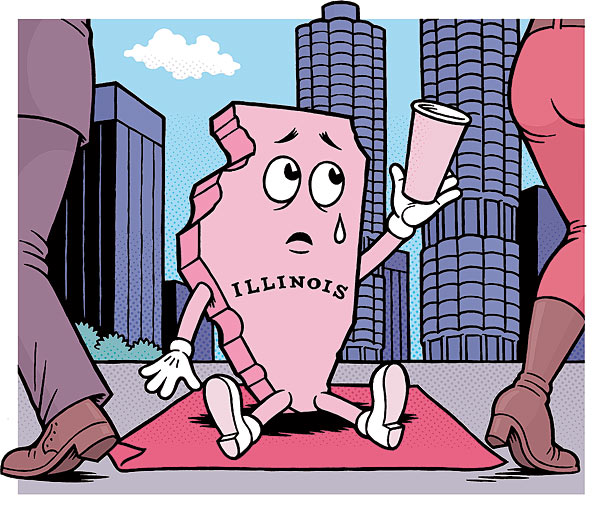
Illustration: Danny Hellman
“Can you spare a quarter . . . billion?”
You’ve seen the headlines: In late January, the bond ratings agency Standard & Poor’s declared Illinois the least creditworthy state in the nation, behind even longtime basket case California. (While a grade of A minus may be pretty good in school, it’s not in the credit world; see sidebar below.) In February, the Tribune’s editorial board pointed out that another prominent ratings agency, Moody’s, ranked Illinois’s credit equal to that of the African nation of Botswana.
Why is this such a big deal?
Here are three big reasons:
Because roads and buildings around you could start crumbling.
On January 30, five days after S&P downgraded Illinois’s credit rating, Governor Pat Quinn pulled the plug on the planned sale of $500 million worth of 25-year bonds. The proceeds would have gone toward projects such as transportation upgrades and school construction.
It’s not hard to see why he made that call. A bond is a promise to pay borrowed money back with interest. Every credit downgrade means an increase in the amount of money a state will have to shell out to induce people to buy it. Take those bonds Quinn nixed. If Indiana—which has a triple-A rating—were to issue them, it would pay an interest rate of about 2 percent, according to Bloomberg market data. Illinois, by contrast, would have to pay around 3.4 percent. That translates into tens of millions extra that Illinois would have to spend to compensate investors for the added risk of buying those bonds.
Delaying bond issues can delay infrastructure projects, which can further hurt the state’s economy and, in turn, further hurt tax revenues. It’s a vicious cycle.
Because your taxes could go up.
When it gets dauntingly expensive to borrow money, a government starts looking around for another way to raise cash—and taxpayers are a logical source. Moody’s hinted as much when it rated the state’s now-withdrawn bonds, saying that Illinois’s grade could slip yet again unless lawmakers extend the short-term income tax hike they passed in 2011, which raised personal rates from 3 to 5 percent and is scheduled to lapse to 3.85 percent in 2015. Alternatively, the state could cut pensions, health care, and other expenses to offset the expired tax increase. Not good.
Because if the downward trajectory continues, Illinois could wind up defaulting.
Now no one is suggesting that this is a likely scenario; a rating of A minus is still considered low risk. (It’s one level above junk status, when the risk of default really starts to zoom.) But it’s worth noting that states can and do default on their debt. Arkansas did in 1933, during the Depression, when it declared bankruptcy.
The results weren’t pretty. Bondholders suffered, of course, but so did Arkansas residents. The state hiked auto and gas taxes, implemented its first sales tax, and slashed spending on social services, hitting the poor hard. It took another 16 years for Arkansas to release a highway bond and decades to pull out of its economic slump.
For Illinois to raise its credit rating, it must reduce its liabilities—or at least show that it’s making significant efforts to do so. (In explaining the January downgrade, S&P cited not just the state’s poor pension funding—anything below 60 percent receives four points on its scale of one to four—but also its opinion that reform will be “difficult to achieve given the poor track record in the past two years.”)
Look at California, long Illinois’s competition for the bottom of the barrel. Two months ago, S&P raised the state’s rating from A minus to A on the strength of its multiyear budget plan and a projected budget surplus. That’s still four notches from the top. But it’s a start.
* * *
How the States’ Credit Compares
The higher a state’s rating, the lower the interest it must pay bondholders.
AAA
Alaska, Delaware, Florida, Georgia, Indiana, Iowa, Missouri, Nebraska, Nevada, North Carolina, Utah, Virginia, Wyoming
AA+
Idaho, Kansas, Massachusetts, Minnesota, New Mexico, North Dakota, Ohio, Oklahoma, Oregon, South Carolina, South Dakota, Tennessee, Texas, Vermont, Washington
AA
Alabama, Arkansas, Colorado, Connecticut, Hawaii, Louisiana, Maine, Maryland, Mississippi, Montana, New Hampshire, New York, Pennsylvania, Rhode Island, West Virginia, Wisconsin
AA–
Arizona, Kentucky, Michigan, New Jersey
A
California
A–
Illinois


